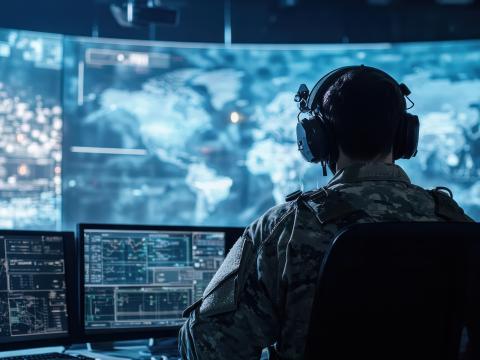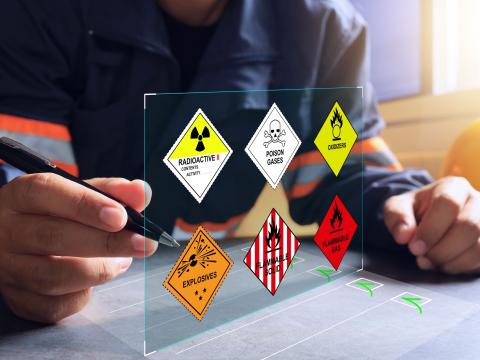U.S. Army Modifies Its EW Approach To Counter Drones and More
As drone warfare progressively takes over today’s battlefields, the U.S. Army is working to enhance its electronic warfare (EW) capabilities in an increasingly complex environment.
“That’s a very difficult problem set,” said Chief Warrant Officer 5 (CW5) Richard Godfrey, senior warrant officer adviser for the U.S. Army Cyber Capability Development and Integration Directorate, or CDID.
“One proliferation of software-defined radios makes this very, very difficult because not all drones are operating on the same frequencies. Frequency bands may not even be on the same waveform,” he told an audience during a panel discussion at TechNet Augusta 2025 on August 20 in Augusta, Georgia.
Godfrey was joined on stage by moderator David May, senior cyber intelligence adviser for the U.S. Army Cyber Center of Excellence and U.S. Army Training and Doctrine Command; Eric Bowes, program officer of the Army Reprogramming Analysis Team, Program Office, Intelligence, Electronic Warfare and Sensors; Col. Leslie Gorman, Army capabilities manager, electromagnetic warfare, CDID; and CW5 Mark "Al" Mollenkopf, USA (Ret.), science adviser to the commanding general, U.S. Army Cyber Command.
“To see and identify and create a counter in the amount of time that it takes to fly a drone across the battlefield, it has to be rapid,” Godfrey continued. “I don’t know if that’s something that we could do in the next 10 years.”
Godfrey said he hopes it can be done; however, drones have surpassed artillery as the No. 1 killer on the battlefield. The issue remains a significant challenge, he stressed.
Echoing Godfrey’s statement, May drew from the ongoing war in Ukraine.
“There were two major reasons for the successful Ukrainian incursion into the Kursk Oblast region in August of 2024, and it was drones and EW,” he stated.
While Russian authorities have since claimed to have regained control over the region, the operation did reportedly take the Russian military off guard. According to May, that was largely due to the Ukrainian military’s modification of its systems.
“[The Ukrainians] had the latest and greatest software on the EW side, and they also modified the frequencies to support their drone attacks,” he said. “The Russians were unaware, and it led to a strategic surprise in the capturing of some significant terrain.”
Bowes followed this by highlighting that there is not “one silver bullet” to meet the counter drone challenge. “It’s probably a combination of non-kinetic effects, kinetic effects, directed energy weapons, that are really going to be able to handle the entire threat across the board,” he stated.
Extended range visibility and reach to fully comprehend the battlefield is critically important for situational awareness and decision-making, Bowes emphasized.
The speakers additionally noted the U.S. Army’s current investment in EW.
“The Army has recognized the significance of electromagnetic warfare in modern warfare,” May stated, mentioning the Army EW strategy that was released in March. “It’s nested with the [secretary of defense] directive for 2025 as well as the Army transformation initiative, and we are actively pursuing an implementation plan that will operationalize the goals and objectives within that strategy.”
Notably, a July press release from the Program Executive Office for Intelligence, Electronic Warfare and Sensors mentions the Army’s 2027 goal to achieve electromagnetic dominance.
“Furthermore, the Army recently stood up a three-star forum, which we like to refer to as the EW board of directors to help oversee the execution of that strategy,” May continued.
Referencing the Ukraine-Russia war, May also said the Army is rapidly integrating lessons learned into programs of record.
“At the operational level, we’ve recently written a [multidomain operations] range guide, which will allow a platoon leader, infantry or armor to take a regular range and turn it into an [electromagnetic spectrum] contested range to practice their emissions control,” he stated.
May additionally shared the recent decision to double the size of the Army’s EW platoon at the mobile brigade combat team, “recognizing that we need more capability at the tactical edge.”
Within the next five years, May continued, the Army looks to build out 18 EW companies across COMPO 1 and COMPO 2.
We’re even investing in EW capability at the theater level, within the multidomain effects battalion.
“We’re even investing in EW capability at the theater level, within the multidomain effects battalion,” he said. “We’re even updating our policies so that they are more aligned with allowing us to reprogram.”
May then turned the discussion over to Gorman, who further spoke on operationalizing EW.
“A lot of focus right now [is] … on addressing … getting capability ready, prototyped out for those companies that are going to be operationalized or activated at division starting around [fiscal year 2028],” she said.
Noting the need for modular EW capability, Gorman mentioned the terrestrial layer systems electromagnetic warfare.
“We’re looking for it to be a more modular capability so it can be moved from vehicle to vehicle,” she noted. “I think we’re past that point of [having] a dedicated EW vehicle … trying to move across a battlefield, [with] antennas, looking like a porcupine.”
The Army has also recognized the need for an aerial EW asset, Gorman noted, especially when it comes to electronic attacks.
“Along with Army Transformation Initiative, where we recognize some of those primary or larger movers—say, the Gray Eagle—your type-three, type-four class UAS [unmanned aerial systems] are going to probably be phased out in the years to come,” she stated.
Gorman’s office is therefore exploring ways to work with EW to potentially put sensors on those UAS.
With the modular and platform agnostic approach, Gorman noted the need for lighter weight chassis, including the potential of dual-use EW sensors. “You can do a lot with [software-defined radios],” she added.
“What can we modify on software on some of these sensors and effectors on the battlefield to get that modularity that can be integrated in multiple fighting platforms?” Gorman posed.
TechNet Augusta is organized by AFCEA International with help from the U.S. Army Cyber Center of Excellence. SIGNAL Media is the official media of AFCEA International.




Comments